Note: If an image ever fails to appear - refresh your page, it really is there
Flags that have flown over the State of Mississippi
Mississippi has a long history going back to the Mississippian culture that developed along the Mississippi River and its tributaries about 950 CE. These people built giant pyramid-like mounds and complex settlements, but they had mostly disappeared before European´s came. Their descendants still remained as the Chickasaw, Choctaw, Natchez, Yazoo, Pascagoula, and Biloxi.
The first major European expedition into the territory was that of Hernando de Soto who passed through in 1540. The French came next claiming the territory that included Mississippi as part of their colony of New France and started settlement. Pierre Le Moyne d'Iberville built Fort Maurepas on the site of modern Ocean Springs (Old Biloxi) in 1699. In 1716, the French founded Natchez as Fort Rosalie; it provided the largest settlement and trading post in the area. After the French and Indian War (or Seven Years War) the English gained control of all the French New World possessions. In 1783 the Mississippi area was deeded by Great Britain to the United States after the American Revolution under the terms of the Treaty of Paris.
The French and later Spanish colonial rule introduced enslaved Africans into the mix. The attraction of vast amounts of high-quality, inexpensive cotton land attracted hordes of settlers in the late 1780s and 1790s, mostly from Georgia and the Carolinas, but also from the tobacco areas of Virginia and North Carolina. Before 1798 the state of Georgia claimed the entire region between the Mississippi and Chattahoochee rivers and tried to sell lands there, but in 1804 the area was all added to Mississippi Territory, which included most of both modern Alabama and Mississippi. The territory initially was sparsely populated and suffered from native unrest and a series of claims and counter-claims that hampered its development. The Treaty of 1795 had technically ended Spanish control over Mississippi, but Spain continued to hamper the territory's growth by harassing commercial traders.
Not until the emergence of cotton as a profitable staple crop after the invention of the cotton gin in 1794, and the development of plantations with slave labor, did the riverfront areas of Mississippi begin to flourish. In 1817 elected delegates wrote a constitution and applied to Congress for statehood. On December 10, 1817, the western portion of Mississippi Territory became the State of Mississippi, the 20th state of the Union. Natchez, long established as a river port was the first state capital, but in 1822 the capital was moved to a more central location at Jackson.
Mississippi has a long, rich and eclectic flag tradition dating back to Hernando De Soto´s trek through territory that would eventually become the Magnolia State. Early flags used by the Spanish explorers, French explorers, the French Empire, the Spanish Empire, Great Britain, the United States and the Confederate States all played a part in the Mississippi story.
In reference to the Civil War, thus far nothing has turned up to suggest that any type of state or Confederate flag was ever purchased for display at the Mississippi State capitol. Sherman and other Union units sacked the capitol more than once, and took a pretty good inventory of the stuff that they made off with. At no time do they ever mention flags. The state of New York does claim to have a flag that they captured from the capitol building, but if they did, it wasn't documented at the time, and we don't know anything more about it.
Here then, are some of what we do know about of some of the historical flags of Mississippi.

Spanish Royal Standard
|
Spanish Flag of Castile and Leon 1540
Hernando de Soto was a Spanish conquistador who landed in present-day Florida in 1539, then led an expedition exploring the southeastern and midwestern parts of North America carrying this flag.
In 1540 he led his followers into Mississippi, and his was the first expedition documented to have crossed the Mississippi River. De Soto's North American expedition searched for gold, silver and even a passage to China. De Soto died in 1542 on the banks of the Mississippi River in what is now Arkansas or Louisiana.
|

British Union Flag
|
King's Colors - British 1683
In 1663 King Charles II´s land grant established Carolina whose westward border was then considered the Mississippi River. Therefore, technically this flag held dominion over that vast territory which included Mississippi. In reality, the western area was not explored or populated by the British during this period, and most likely this flag probably never actually flew over Mississippi.
However, the British Union Flag would have a chance to fly over Mississippi 100 years later after the French and Indian Wars. In 1763 Great Britain once again gained control over the area after the French defeat, but eventual ceding it to the United States in 1783 after the American Revolution. |

fleur-de-lis of France
|
Bourbon Flag of France 1682-1763
The French explorers Cavelier and La Salle claimed the Mississippi Valley in 1682, naming it Louisiana in honor of King Louis XIV. In 1699 Sieur d'Iberville established the first permanent settlement in Mississippi near present-day Ocean Springs.
Between 1699 and 1763 the French colony of Louisiana, of which Mississippi was part of, remained under French control. The French explored the region, established settlements and military outposts, and developed relations with the area’s natives, much like they were attempting in Canada and the Ohio River Valley. Unfortunately for them they were unable to achieve their goals in the region, and would later lose all control over the area to the British at the end of the Seven Years War. |
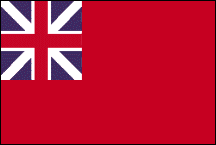
British Red Ensign
(after Seven Years War)

British Red Ensign
(during War of 1812)
|
British Red Ensign 1763-1783
At the end of the worldwide struggle of the Seven Years War, fought between the French and English and their allies, the dominion over Mississippi once again passed to the English. What had started in the Ohio River Valley as the French and Indian War, now resulted in new colors (the British Red Ensign that had been adopted by Queen Anne in 1707) being raised at Natchez, Baton Rouge, Mobile, and Pensacola in 1763.
In 1763, British Commander Robert Farmar landed with his British regiment at Fort Conde near Mobile, Alabama, to begin the process of securing those new lands ceded by the French. As the British formally occupied French Forts, including those in what is now Mississippi, they did so by hoisting their "ships ensigns", as they apparently had no "proper land flags" at their disposal. The Red Ensigns were all they had. So, the first British "flag" to officially fly over Mississippi was a British naval ensign. Later in the year, Farmar wrote the British Governor in Kingston, Jamaica, requesting "proper land flags" for general usage on land. Although the State of Mississippi currently has no record of any return correspondence from the governor, it is assumed that Farmar eventually received his "land flags", most likely the King's Colors, or Union flag. After 1707, the Union flag was fast becaming a "de facto" British national flag, and the Red Ensign would see wide use in the colonies by His Royal Majesties´ land forces.
As a result of the outcome of the American Revolution, Mississippi would next become part of the territories ceded to the fledgeling United States of America at the Treaty of Paris, and the British flag would be retired from Mississippi. However, the Red Ensign of 1801 would be raised again briefly over Ship Island, located off the Mississippi Gulf Coast, during the War of 1812.
|
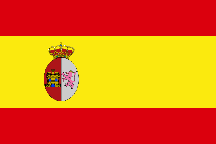
Spanish Bars of Aragon
|
Flag of Spain 1785-1898
Under the provisions of the Treaty of Paris of 1763, France ceded its territory east of the Mississippi River to England, and its territory west of the river, along with New Orleans, to Spain. Manuel Gayoso would served as the first Spanish governor, first at Fort Natchez, and later in New Orleans.
Fort Natchez had been established decades before in 1716 as "Fort Rosalie" by the French. Later, the fort was known officially as "Fort Panmure" by the British, however, most people simply called it "Fort Natchez." During his time as Goveror-General, Gayoso worked tirelessly to transform Mississippi into a viable and productive unit of the Spanish empire, only to have it turned over to the United States in the end.
His city of Natchez continued to thrive after Spanish withdrawal and served as the first capital of the Mississippi Territory. Later it served as the first capital of the state of Mississippi and was the largest and wealthiest city in Mississippi for decades afterward. The Spanish did not completely relinquish their claims until 1798, and in 1810 the United States annexed West Florida from Spain, including what is now southern Mississippi.
|

French Tricolor
|
French Empire 1800-1803
The French indirectly once again controlled Mississippi in 1800, through its ally Spain, in reality a puppet of the French Empire. Napoleon Bonaparte had gained Louisiana from Spain under the secret Third Treaty of San Ildefonso. Louisiana remained nominally under Spanish control until a transfer of power to France on November 30, 1803, just three weeks before the cession to the United States.
Under Napoleon Bonaparte, France had took back the territory in 1800 in the hope of building an empire in North America, but a slave revolt in Haiti and an impending war with Britain, led France to abandon these plans and sell the entire territory to the United States, the famed Louisiana Purchase. In a strange ceremony, the Spanish flag was lowered, the French flag raised, then the French flag lowered, and the United States flag raised. |
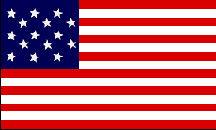
US 15 Star Flag 1795
|
United States of America 1798-1818
Parts of Mississippi were first organized as a territory of the United States in 1798 from land that was disputed by the United States and Spain, even before the Louisiana Purchase of 1803. The Territory of Mississippi was an organized incorporated territory of the United States that existed from 1798 until 1817, when the final extent of the territory was admitted to the Union as the state of Mississippi. This area extended from 31º N latitude to 32º28' North, or approximately the southern half of the present states of Alabama and Mississippi. The Mississippi Territory was expanded in 1804 and again in 1812 until it extended from the Gulf of Mexico to the southern border of Tennessee.
The flag flying over the United States at this time was the only United States Flag to have more than 13 stripes. In 1818 an act was passed by Congress that a new star would be added in the future for each new state, but the number of stripes would always remain at thirteen to honor the original colonies. However, there was no provision for how the stars should be arranged. |
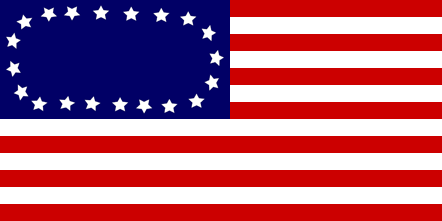
US 20 Star Flag 1817
|
United States of America 1817
When Mississippi joined the Union as the 20th state in 1817, because there was no provision for how the stars should be arranged, this unusual circular union was one used on this rare Mississippi national stars and stripes. This flag represents one of only four known surviving 20 star flags. It is currently in the collection of the Museum Division, Mississippi Department of Archives and History, and undergoing restoration.
|

Bonnie Blue Flag
|
Republic of West Florida 1810
Sovereign Republic of Mississippi 1861
The United States claimed West Florida as part of the Louisiana Purchase of 1803, but the claim was disputed by Spain. Spain claimed that West Florida was a part of its Florida colony, not part of Louisiana. While the United States and Spain negotiated on the status of West Florida, American settlers led a rebellion in 1810 and establishment the independent Republic of West Florida, with its capital located at St. Francisville on a bluff overlooking the Mississippi River in present-day Louisiana. The Bonnie Blue flag flew over the territory briefly for 74 days.
The most famous instance of a flag being raised over the Mississippi capitol building is when the state seceded from the Union in 1861. The Bonnie Blue flag was draped from the rotunda signifying session in 1861. That particular flag is now lost to history, but it was quickly replaced by the Magnolia Flag in any case.
|

Stars and Bars 1861-1863
 Stainless Banner 1863-1865 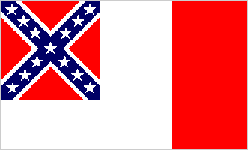 The Blood Stained Banner 1865 |
Confederate States of America 1861-1863
During the Civil War there were basically three national flags for the Confederacy. The first two saw use in Mississippi, and possibly the third, although not documented.
The First National Flag eventually had 13 stars. The admission of Kentucky and Missouri in September and December brought the circle of stars to thirteen. The Stars and Bars was proudly displayed by the people of Mississippi during the "War between the States." However, it was said that during battle this flag was sometimes confused with the Union Stars and Stripes, therefore it was replaced by the 2nd National flag in 1863.
The Confederate Congress seeking a more "Confederate" flag, and to honor the battle flag of the Army of Northern Virginia, decided to replace the First National Flag. Therefore, in 1863, a second design was adopted, using the "Southern Cross" Battle Flag as the canton on a simple white field. This second design was called "the Stainless Banner" and is sometimes referred to as the "Stonewall Jackson Flag" because its first use was to cover Stonewall Jackson´s coffin at his funeral.
It was soon discovered that the Second Confederate National Flag was easily mistaken for either a white flag of surrender or parlay flag, especially when the air was calm and the flag hung limply, and it was decided that this flag also had to be slightly modified. In 1865 it was officially replaced by the third and last Confederate National flag which had a large vertical red stripe placed along its right edge.
The third Confederate flag was not widely used because of the rapidly approaching end to the Civil War. It was reported being used at the capitol in Richmond by the Richmond newspapers in December of 1864, but It should be pointed out that there is no evidence that this or any other Confederate or state flag ever flew over the capitol building in Mississippi during the Civil War. The last Confederate national flag has sometimes been called the "Blood Stained Banner." |
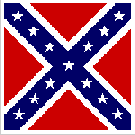
Southern Cross Flag
|
Confederate Battle Flag 1861-1865
This battle flag was used by Mississippi troops when under the command of General P.G.T. Beauregard, who apparently designed the original. It later was made the canton of Mississippi State flag. There were both non-fimbriated and fimbriated versions of the flag being used.
It was in use in battle beginning in 1861 until the fall of the Confederacy. The blue color on the saltire in the battle flag was navy blue, as opposed to the much lighter blue of the Naval Jack. The flag's stars represented the number of states in the Confederacy. The distance between the stars decreased as the number of states increased, reaching thirteen in late 1861.
|
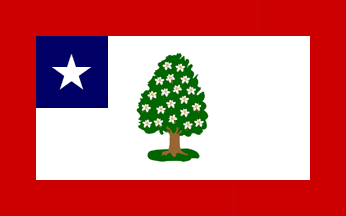
The Magnolia Flag
|
Confederate State of Mississippi Flag 1861-1894
The State of Mississippi was also briefly called the "Sovereign Republic of Mississippi" prior to the formation of the CSA, and used "...a Flag of white ground, a Magnolia tree in the centre, a blue field in the upper left hand corner with a white star in the centre, the Flag to be finished with a red border and a red fringe at the extremity of the Flag."
This flag would continue to be used as the state flag of Mississippi until 1894 when legislation that led to the adoption of a new official State flag was approved. The legislation authorized a committee to design a new State flag that would become the official State flag.
Learn more about Mississippi's Magnolia Flags here. |
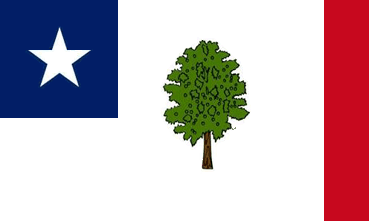
Suppositious Magnolia Flag
|
Mississippi United Confederate Veteran´s Flag c1866
This variant flag design was most likely a post war flag. It was used by one or more Mississippi United Confederate Veterans units, and over time became mistakenly identified as the original Magnolia flag.
This suppositious flag, actually dating from the decades following the Civil War, can be found in
many different sources who copy each other, and the flag is now commonly being manufactured as the Magnolia flag. A suppositious flag or flag story is one based on a mistake, but which has been repeated so many times it has become accepted as real.
Learn more about this and other Mississippi Magnolia Flags here. |
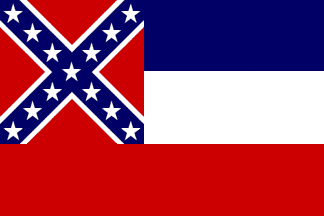
Mississippi Flag
|
Mississippi State Flag 1894-1995
The flag illustrated here is only one variant of the Mississippi State flag that existed between 1894 and 1995. During this period, the dimensions of the Southern Cross, the size of the stars, and their orientation were not standardized. There were literally dozens of variants of the Mississippi flag. There were both non-fimbriated cantoned versions and the fimbriated cantoned versions of the flag being used interchangeably by the state government until 1995.
Although the flag would be finally standardized in 1995 to make it more heraldically acceptable, many of the non-fimbriated canton versions of Mississippi flag can still be seen flying here and there in Mississippi. Overtime it is assumed, as they are replaced, they will gradually disappear, but they still continue to be used interchangeably by the general public. |
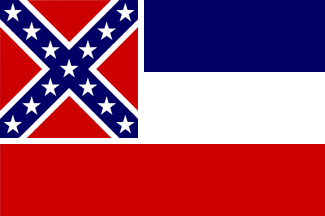
Standardized Mississippi Flag
|
Mississippi State Flag 1995-2019
The Mississippi Flag was standardized in 1995 at the request of the governor who noticed that different flag variants were being flown on government buildings. Until then there were no specifications for the Mississippi State flag as to where the stars should be placed, what their size should be, what direction they should point or if the canton should be fimbriated. In 1995, Governor Kirk Fordice sent an official memorandum, largely based on the work of Mississippi vexillologist Clay Moss, to every manufacturer and officially standardized the format of the canton.
Specific language was written stating that fimbriation would flank the fly end and bottom of the canton, and it included a detailed set of construction specifications for the official state flag. |

Proposed Referendum Flag
2001

Stennis Proposed State Flag
2018

Mighty Magnolia Flag
2018
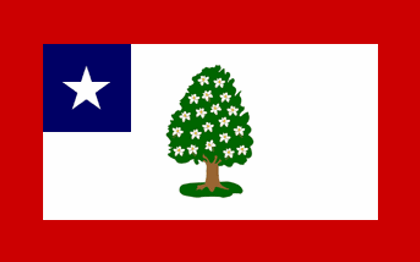
The "captured" State Flag
1862
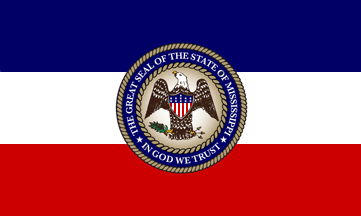
Modified Bicentennial Flag
2017
|
Proposed Referendum Flag 2001
In 2001 a flag referendum was declared offering this flag as an alternative to the standardized flag of 1995. It basically replaced the controversial Southern Cross with a star pattern. It had a blue canton with 20 stars. The outer ring of 13 stars represent the original 13 colonies. The next ring had six stars representing the six nations that historically had sovereignty over the Mississippi territory prior to statehood. These were Native Americans, the French, the Spanish, the British, and the United States and the Confederate States. The inner and slightly larger star represented Mississippi itself, and the 20 stars also indicated that Mississippi was the 20th state.
The Mississippi referendum resulted with approximately 60% of those voting favoring keeping the standardized 1995 flag, which was based on the 1894 flag design. Thus, the proposed 2001 flag design has become just another interesting notation in Mississippi flag history.
However, since the Mississippi flag referendum in 2001, several different "alternative" Mississippi state flags (without the controversial CSA Battle flag in the canton) have been flown or suggested by those still unhappy with the referendum results. One alternative has been suggested by Laurin Stennis, a Mississippi artist and granddaughter of the late Senator John C. Stennis. On her suggested flag nineteen stars form a circle around a larger center star, which represents Mississippi as the 20th state to join the Union in 1817. The centering of the blue star on the field of white is an inverted "Bonnie Blue," a reference to the state's secession (1861-1865).
The Mighty Magnolia Flag is the result of two years of researching Mississippi culture, symbolism, and history by design student Chase Quarterman. What started as a Master's Thesis turned into the Mighty Magnolia Flag proposal. The Mighty Magnolia flag is divided into 3 vertical sections of Old Glory Red, White, and Old Glory Blue. The central white section is curvilinear with a diagonal (top central to bottom left) orientation. A white magnolia is located at the center of the Old Glory Blue field. The wavy white strip represents the Mississippi river.
Another suggested "alternative" state flag, made by Mississippi Vexillological Researcher Clay Moss, is based on the only known actual remaining Civil War era state flag. It was captured by the 2nd Iowa Cavalry on May 30, 1962, just north of Booneville, Mississippi. It is currently in the possession of the State Historical Society of Iowa in Des Moines.
According to Moss, this surviving Civil War era flag matches the 1861 Mississippi state Magnolia flag written description more closely than any other currently discovered surviving Magnolia sample, and he feels it could make an acceptable "alternative" state flag to fly for those unhappy with the current official flag. He also stated he personally has no objection to the 1995 flag design that he standardized either.
The Mississippi Economic Commission introduced a blue/white/red horizontal tri-bar with the Mississippi state seal centered as a Mississippi bicentennial flag in 2017. It had the words "Established 1817" on the hoist side of the centered state seal and "2017 Bicentennial" in the white stripe. Afterward, some people apparently covered or removed the lettering in the middle white stripe and are now flying the blue/white/red horizontal tri-bar with just the centered state seal.
|
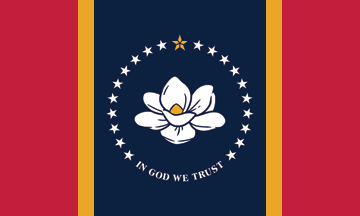
The Magnolia Flag 2020
|
The State of Mississippi Flag 2020
As the State of Mississippi continued to wrestle with a decision to replace its existing state flag with its controversial Confederate battle flag in the canton, a sudden decision in 2019 came from its legislature to once again to replace the existing flag. It generated field of about 3,000 public submissions, with the only requirement being it had to contain the text "In God We Trust" somewhere in its design.
A special Mississippi Flag Commission has appointed and a new design selected from the submissions. Once again the Mississippi public was given the choice to approve or disapprove a proposed design. During the Presidential Election in November of 2020, the Mississippi voters did approve the new design and the "Magnolia State" had its new flag.
The final design reflected the efforts of Mississippi graphic designers Rocky Vaughan of Ackerman and Kara Giles of Oxford. They each tweaked the design to strengthen elements. The magnolia (the state flower) drawing on the flag came from Sue Anna Joe, a Greenwood native living in San Francisco. Micah Whitson, a University of Mississippi graduate now living in Boston, designed the Native American star to honor the original state inhabitants. Illustrator Clay Moss made this final drawing used here of the flag. |
- My thanks to Clay Moss for his invaluable help and input on this page -
| Top of This Page | Flags of the United States | Home Page |
|